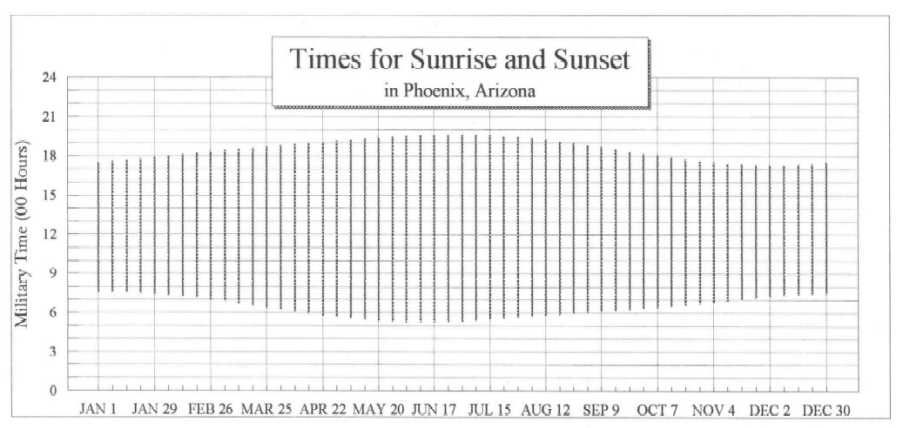
|
DESIGNING DWARFS in the DESERT, up through the first thirty-five years of the Phoenix Bonsai Society
by Robert J. Baran
PYRAMID DANCER PUBLICATIONS
|
This is the official history of the club, its five hundred plus members to date, and its three teachers, where they came from, how they became involved in horticulture and bonsai:
| Paul Matsusaki (1906-70), the founder (1962) and a champion of traditional Japanese values, |
|
|
| Leroy Fujii (1925-98), the co-founding member who filled Paul's shoes as teacher for most of the club's existence, and |
|
|
|
John Yoshio Naka
(b. 1914),
now recognized worldwide as a grand master of the art, he was befriended
by Paul and taught here before this club was started; |
| the histories of the world-reknown Heard Museum and Desert Botanical Garden , and the Valley Garden Center (where the Phoenix Bonsai Society has met and now meets); |
|
|
| the Japanese-American and Chinese-American communities here; |
|
|
| the Tucson Bonsai Society, sister club (1972) and host of the American Bonsai Society's 1999 Symposium; |
|
|
| contemporary events and other teachers in the world of bonsai who have interacted with and taught our club members; |
|
|
|
the
only
book available which gives information specifically about growing bonsai in a desert
environment. (Note: in the interest of truth in advertising, please be aware that
desert bonsai
care
information can now be found in greater detail on
the Phoenix Bonsai Society web site. The history portion of
Designing Dwarfs
remains exclusive to that publication.) |
|
"The amount of research that went
into this comprehensive report on bonsai growth must be applauded. This reviewer
was intrigued by the formatting of the text. The short paragraph on each
development reminded this reviewer of Walter Winchell's staccato reporting of the news
on his Sunday radio broadcast - succinct, lively and interesting. "This book is highly recommended for those interested in the history of bonsai, not only in Phoenix, but in the United States." (Jane Nelson, ABS Bonsai Journal, Summer 1998, pg. 61) |
Overseas, please contact us for shipping & handling pricing at rjb@magiminiland.org
* * * * *
In the interest of historical accuracy, the following are errors now known to exist in this book. A handful of typographical errors, verbs not agreeing with the noun number, multiple use of the same descriptive word on a single page, etc. are also in there but do not require further comment. In the maroon braces below can be found the word or passage in question. If you are aware of any other significant discrepencies, please e-mail rjb@magiminiland.org . |
| pg. ii, bottom : { PayBS Pa r son Bonsai Society } The group should, or course, be "Payson." Spell-check software is only good up to a point. (If this were an edition of the Bible, it could be knicknamed the "Parson Version.") |
|
|
|
pp. 14-15 : bottom margins should be a little smaller so that three more lines of text would be on each of these pages.
|
|
|
| pg. 23, top : { These [two bonsai] were " smuggled " into the state... } The quotes should be around the verb to better reflect the gently kidding manner with which Mr. Jacobson related this anecdote. |
|
|
| pg. 28, top : { Listed as supplying labor for the garden pool which was built there: Paul Matsusaki of Toyo Nurseries. } Per a conversation with Elsie Andrade, Feb. 26, 2000 at the Matsuri display, Paul would never have used the black volcanic rock which makes up the sides of the pond. The sentence in question is derived from the Oct. 27, 1963 Arizona Republic article "'Here's How' Gardens." Did Paul just do the labor with other-specified materials? Would he have used materials in a design he did not agree with? According to Elsie, no. |
|
|
| pg. 30, top : { Afterwards [Rex Tsutsumida] moved to Cleveland, Ohio and then New York where he learned English by watching the motion pictures which were changed weekly. } Per a conversation with Rex, Feb. 26, 2000 at the Matsuri display -- the first chance RJB had to speak with Mr. Tsutsumida since the latter's move from the Valley in 1989 -- the subject knew English quite well before moving to Cleveland. I have not found the specific reference in my book notes, but I believe the information came from a conversation with Leroy. I apologize if I misunderstood. |
|
|
| pg. 82, top left : { Matusaki, Paul } index listing for Paul ! I did get { Matsusaki, Edna (née Tani) } right above him correct. |
| Four additions to the text could be as follows: |
|
|
|
pg. 5 : Meanwhile to the south, a complex of canals and fields dating back to 1200 B.C. outside Tucson is
the oldest documented irrigation system in North America. The Las Capas waterworks tapped the nearby Santa Cruz
River to irrigate as many as 100 acres for crops such as corn. (Per "Archaeology's top 10 finds of 2009, Early irrigation in the desert southwest U.S.," msnbc, Dec 30, 2009) |
|
|
| pg. 62, bottom photo caption : Sam Lew, Jr. (right of center) models a club jacket. |
|
|
| pg. 75, bottom photo caption : The height from base to top is approximately 15 inches. |
|
|
|
A chart showing the length of daylight throughout the year in the Phoenix
area was cut due to space considerations. It was originally found on the club's Seasonal Care
page, which has since been deleted. So here is the chart:
|
|
|
|
Per an email to RJB when Max Miller was editing his Bonsai Book of Days listing
(Mar 15), the following memories of his trip to
Japan in 1983 (pg. 64) are thusly corrected: "He met several young Japanese engineers in the next several years while attending annual International Gas Turbine conferences. Max would ask them if they raised bonsai. He knew that they would say no, because they worked very long hours for their companies. Then he would ask them who raised the bonsai, and they would reply the old men. In response to the pestering, one of his Japanese colleagues said 'come to Japan and I will show you bonsai.' So, during a business trip to Japan in 1983, this colleague took Max to see two bonsai nurseries in Okayama Prefecture. The owner would not be able to speak English and Max would not know Japanese, but the two would end up having a wonderful conversation about bonsai with his colleague serving as an interpreter. The owner would be impressed by the gaijin (foreigner)'s interest." In the club's July 2020 newsletter/email, Max told his memories of the dig that we took part in at the end of July 1993. The earlier telling can be found on pg. 65 : "A dig Saturday morning July 31 on the side of Mummy Mountain in Paradise Valley rescued a number of large-trunked thirty-five-year-old bougainvilleas, natal plums, and other landscaping that was scheduled to be torn up for a waterline replacement along about 900 feet of private driveway. Branches were trimmed and mulched, the plants were dug and bagged, and the area cleaned up by club members in only five and a half hours. A few of the trees would be ready for display in two years." Because of space restraints that is all of the story that could be told in Designing Dwarfs. To the historical record, we now add Max's memories: "...I think that the Mummy Mountain dig happened before you joined the club, so you may not know the story about how it happened. Elsie and maybe others still remember it. "It was 1993 and Mr. Franke, who was the CEO of America West Airlines at the time, had a house sitting back about a quarter of a mile from the street part way up the north side of Mummy Mountain. One of our members, Fredrick Davis, was working as a part time handyman for Mr. Franke. The water supply line that ran from the street to the house was buried under dirt in the ditch above the driveway. The water line needed to be replaced for some reason, and Mr. Franke decided to move it to the lower side of the driveway. I am not sure why, but the old line needed to be removed. There was a problem though, because a lot of bougainvillea and some other plants were growing in the upper ditch and had to be removed to access the old water line. Fredrick told Mr. Franke that he could hire a contractor to dig out the plants, or... he had some friends who might dig them out for free if that was okay with Mr. Franke. Mr. Franke decided to let Fredrick's friends dig out the plants. "So Fredrick organized a dig for the club for Saturday morning, July 24th [sic]. We met at Fredrick's house at 7 a.m., as I recall, getting an early start ahead of the heat. We arrived at Mr. Franke's house before 8 a.m. As I recall there were 43 bougainvillea (and a number of other plants that had no interest for me, but did for others). We started by tagging plants that we each wanted. Sort of a first come, first serve scramble as I recall. Shirley and I marked 5 bougainvillea plants that we wanted. "After all the plants were marked, we cut off the tops and threw them in the driveway for later disposal. When we were done the full length of the drive way was filled with branches. Then we dug the plants, bagged them, and put them in our vehicles or somewhere. "Once we had collected the plants, we had to dispose of the tops and there were a lot of tops! Plan A was to bag the tops and haul them away. After filling one bag it was obvious that we needed a Plan B. Fredrick suggested renting a chipper. He called a rental business and reserved a chipper. Sam Lew had an International Scout with a trailer hitch, so he and I drove over to pick up the chipper. It was around 9 a.m. by the time we got the chipper set up. "So we all worked on chipping. Doug Acker and I took turns feeding branches into the chipper. It was a semi-dangerous job, at least a little scary because you had to push the branches down into the bottom of the hopper where the rotating blades were located. Fredrick gave us pick handles to use as pushers. These handles were big and strong and worked really well as long as you didn't slip and let them be caught by the blades. When that happened either the part of the end was chipped away or worst case the handle would split into pieces end to end. We ended up putting 4 of those pick handles through the chipper that morning. The rest of the gang were cutting the tops into smaller pieces and carrying them up the drive to the chipper. We had the chipper set to blow the chips down the mountain side. It was all just desert ground for a long way, so the chips did not cause any problem. It took us two hours to chip all the tops off the driveway. Did I mention that it was hot? "So the club drove away with 43 Mummy Mountain bougainvillea as we refer to them. I don't remember who all were there for the dig, but maybe the others included Gail Acker, Elsie Andrade, Marty Bond, Nona DiDomenico, Robert Gustafson, Bill Mooney, and Joan McCarter. There must have been others, but I don't have any record of who was there. [RJB and Dick Selkirk were also there.] But I do know several people brought Mummy Mountain bougainvillea to workshops for a few years after that. Anyway that is the story of the Mummy Mountain dig on a hot July Saturday in 1993." |
In honor of the tenth anniversary of Designing Dwarfs, we present these color
versions of some of the pictures in it, along with their respective captions: 
|
|
"Assorted ceramic bonsai pots and carved wooden display stands, all made by
Charles Schneck." (pg. 50, bottom)
|
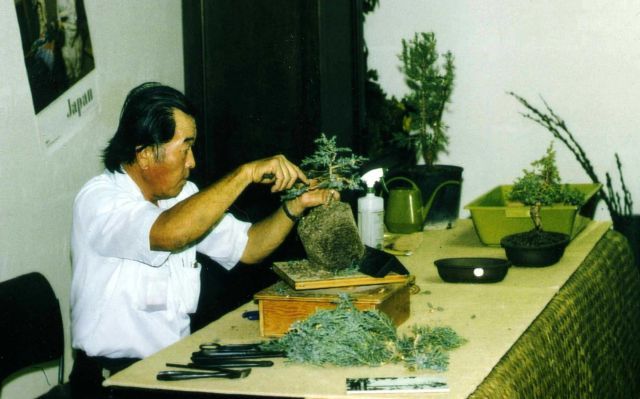
|
|
|
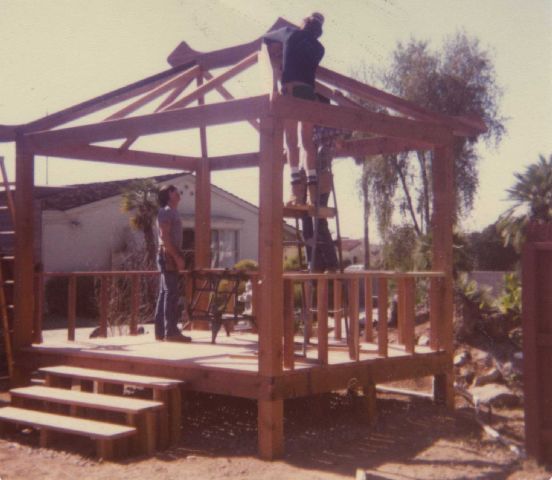
|
|
Many wedding ceremonies have taken place here. Paul Matsusaki-built koi pond is perhaps ten feet beyond the rear of this structure." (pg. 60, top) |
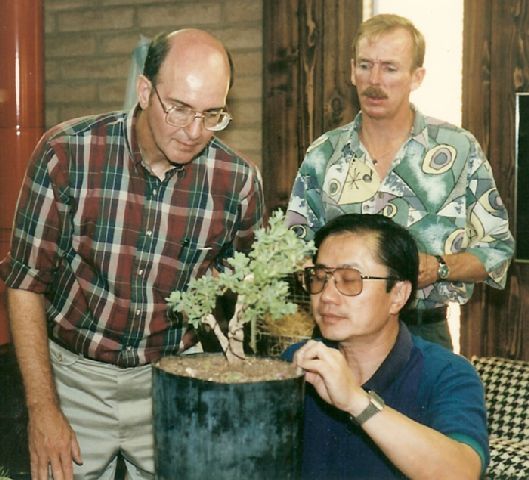
|
|
|
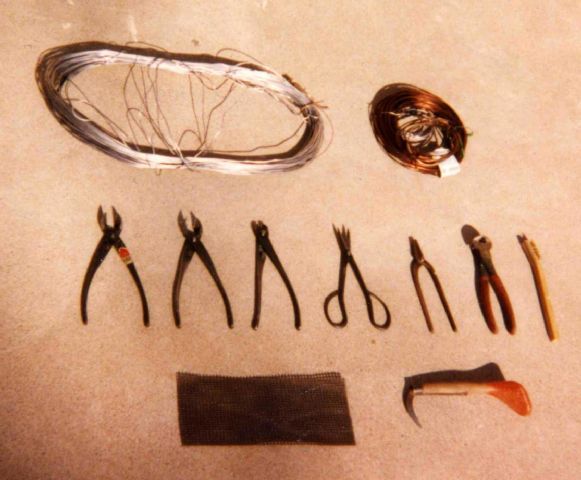
|
|
Top Row: copper-anodized aluminum wire. Middle Row: assorted cutters, scissors, and shears. Bottom Row: drainage screen and dense root rake." (pg. 74, bottom) |
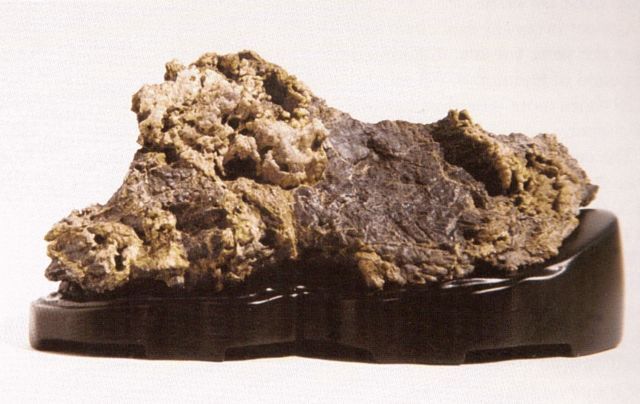
|
|
(Color image from Bonsai Journal, ABS, Vol. 31, No. 4, Winter 1997, pg. 170 |

|
|
The Phoenix Graft, a method by which an interesting piece of deadwood is resurrected as a "bonsai." In Japanese this style is called tanuki, the term for a mythical creature that deceives by changing its appearance. There is some disagreement in bonsai circles as to whether or not these oftimes beautiful creations should really be accepted as a form of bonsai. The main tree shown here is a California juniper, from the club's first Laughlin area dig, that didn't survive. Preserved with lime sulfur, it was then slightly carved to accept the one-gallon Hollywood juniper which was placed up against the back of the deadwood. (Designer: Raheem Hasan)" (pg. 75, bottom) |
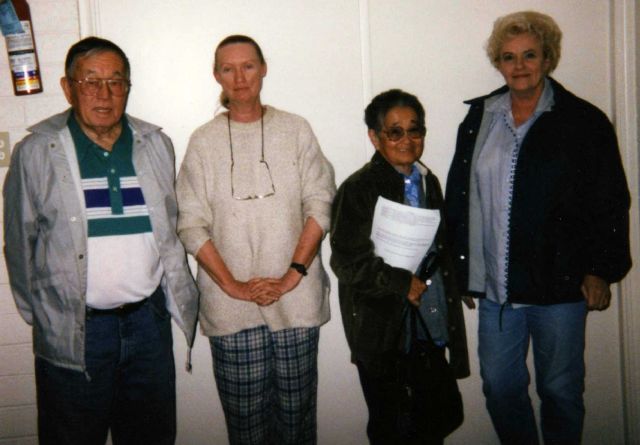
|
|
Leroy Fujii, Joan McCarter, Edna Matsusaki, and Elsie Andrade, February 1997 at the VGC." (pg. 76, top) [Leroy left us in 1998, Joan in 2019, Edna in 2012, and Elsie in 2025. The final total was about 220 years.] |
Finally, to respond to the old negative review on Amazon.com for Designing Dwarfs, the relative lack of information "on techniques for growing Bonsai in a desert climate" is now a moot issue because of the abundance of useful material elsewhere on our website. Please see here, here, and here, for example. Yes, this is definitely more information than could be cross-referenced from Designing Dwarfs' index (11 separate page listings at the bottom of page 82 under "Successful Bonsai in Phoenix"), but because of Amazon's policy of not allowing linkage to external sites, we never were able to add a simple reference to the Designing Dwarfs book page so readers could very easily find much more and updated help. Yes, the book was published as a stand-alone before any thought of content on a club website was considered -- or the website itself was even conceived of. As a historical one-off, the book stands as a guide to early club details. From a larger perspective, it is the start of an archive about this club and what we do. (Many copies of Designing Dwarfs have since had a sticker added to the bottom of the Table of Contents page which references our website's URL address.) |
For the continuation of thePhoenix Bonsai Society's story, see
History Highlights. For the current club year activities, see
Calendar.
